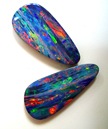Glass filling of
highly included natural ruby to significantly enhance
clarity
Once upon
a time, a by-product of the routine heat treatment of
rubies was the filling of common small surface inclusions
with residual flux from the crucibles used in the
treatment. Now we are seeing cases where highly imperfect
rubies with significant surface fissures have been filled
with lead-containing glass that transforms their appearance
completely.
The material used is often
very low grade pink, red or purplish Madagascar corundum
but glass-filled stones from Tanzania and Myanmar have also
been noted. The effectiveness of the treatment is amazing
in that it transforms opaque and nearly worthless corundum
into material that is transparent enough for use in
jewelry. However, ammonia, bleach, and even concentrated
lemon juice were found to damage the filler by turning it
white at the surface.
Cavities filled with
high-lead glass can be challenging to see under the
microscope, but most samples recently examined by the
Gemological Institute of America contained gas bubbles and
exhibited a blue or orange flash effect at the interface
between the natural material and the filler. Glass is
significantly softer than ruby, and the filled area may
exhibit an inferior polish to that of the natural ruby
host.
This month's sources include The Loupe and GIA World News
Vol. 15 #3

Members of the following:
American Gem Trade Association (AGTA)
American Craft Council
WI Jewelers Association
Jewelers of America
Australian Opal Association
